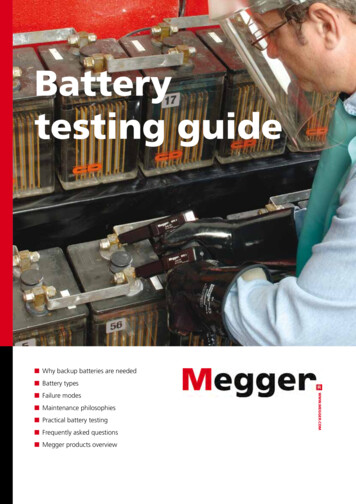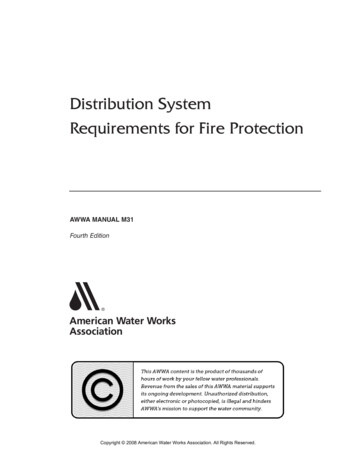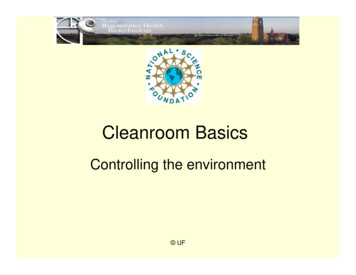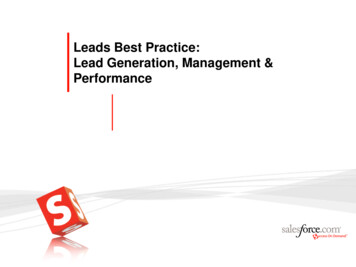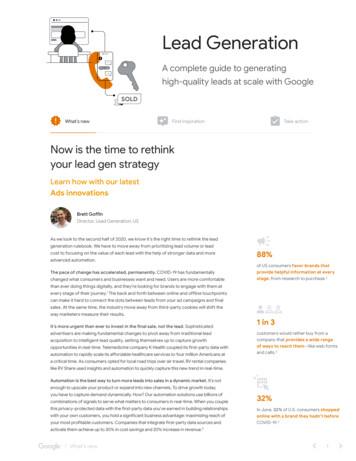
Transcription
HOW TO LEADWORLD-CLASS MEETINGSA GUIDE FOR ENTREPRENEURS AND LEADERSHIP TEAMS
THE UNIVERSAL PROBLEMWITH MEETINGS?INEFFICIENCY.Does this sound like your company’s leadership team meetings? They’re distractions. They interrupt your real work and put youbehind schedule. They’re sporadic. You only meet when there’s a fire to put out, and it’s apainfully chaotic meeting. They’re never focused. Meetings are filled with tangents, sidebarconversations, and wandering discussions that never arrive at solutions. They’re filled with unnecessary people. There’s always at least one personwho didn’t need to attend, which adds to your operation costs and reducesproductivity.We could go on. In fact, on average, business leaders rate the effectiveness of theirleadership team meetings as a 4 out of 10.So how do you fix this problem?“Most companies hatemeetings, so they nevermeet. If you hate meetings,it’s not because meetingsstink. It’s because yourmeetings stink.”MIKE PATON,AUTHOR OF “GET A GRIP”TWEETHow to Lead World-Class Meetings2
START LEADING WORLD-CLASSMEETINGSIt’s possible to hold better leadership team meetings that actually save time andincrease productivity. By leveraging certain key elements, you can put time back intoyour schedule, have a more productive week, and raise the quality of yourcompany meetings from a 4 to a 10. In the Entrepreneurial Operating System (EOS),we call this kind of meeting a Level 10 Meeting .The Level 10 Meeting is where all the magic happens. Most of the traction a companygains is produced in the Level 10 Meeting. It’s incredibly effective because it’s a timemanagement tool. As you and your team come together for 90 minutes each week,you’ll save time by avoiding miscommunication, preventing train wrecks, solving peopleissues, and keeping key people accountable. You may even look forward to theseregular, weekly meetings!This eBook will show you how to have productive meetings that increasecommunication, accountability, team health, and real results.Ready to start leading world-class meetings?Read on to see how it’s done.How to Lead World-Class Meetings3
THE WEEKLY MEETING PULSE Implementing a Weekly Meeting Pulse for your leadership team will create traction byhelping your team stay focused, solve issues, and improve communication. Bringing yourleadership team together each week for 90 minutes gives you an opportunity to makesure everything is on track.The Five Points of the Weekly Meeting PulseA productive Meeting Pulse should meet the following five criteria:1. Same day2. Same time3. Same agenda4. Start on time5. End on timeThese points create a routine, optimize efficiency, and trim the fat from your meetings.“The Meeting Pulse, likea heartbeat, creates aconsistent flow that keepsthe company healthy.”Holding the meeting on the same day and at the same time creates a routine. Starting ontime is key. A late start will eat into your issues-solving time, which is the most importantpart of your meeting. Once you have an agenda that works, stick with it so that you’re notreinventing the wheel each week. End the meeting on time so that you do not create a latestart for any subsequent meetings.How to Lead World-Class MeetingsGINO WICKMAN,CREATOR OF EOS ANDAUTHOR OF “TRACTION”TWEET4
THE LEVEL 10 MEETINGAGENDAThe Level 10 Meeting Agenda is a meeting tool that helps yourleadership team run world-class meetings. It keeps you focused onwhat’s most important, helps you spot developing problems, and drivesyou to solve them. By using the Level 10 Meeting Agenda, everyone onyour team will start accomplishing more.The agenda was created to optimize your meeting efficiency, eliminaterabbit trails, and create a dedicated space for solving issues. It’simportant to go through all seven components of the Level 10 MeetingAgenda in order. Veering from the agenda will put your team at risk offalling right back into old habits.Using the Level 10 Meeting Agenda forces you tolook at and address what is most important, andsolve issues as they arise.DOWNLOAD THE AGENDAHow to Lead World-Class Meetings5
PREPARE FOR THE MEETINGDecide Who Will Run the MeetingThe Facilitator runs the meeting, leads the team through the agenda, and keeps everyoneon track. This person must be comfortable moving people along and pushing themthrough the agenda when the team is getting off-track.Decide Who Will Manage the AgendaPRO TIPSThe Administrator keeps the To Do and Issues Lists updated during the meeting, andTo get the most out of your meetings, holdmakes sure the agenda and Scorecard are updated every week.them in this type of space Arrive 5-10 minutes early to make sure you’re ready on time, especially ifyou’re using any technology during the meeting Set up the conference line if team members will be attending remotely Quiet with no distractions or disruptions Comfortably sized room Open the meeting agenda and Scorecard on your computer Comfortable temperature and well-lit tokeep people awake Open any other documents that will need to be referred to during the Issues Roomy table surfaceSolving portion of the meeting Each meeting participant should have printed copies of all necessary toolsand documents Comfortable seating Whiteboard available Visible clock to help you stay on trackand on timeHow to Lead World-Class Meetings6
DURING THE MEETING SEGUE SCORECARD ROCKS HEADLINES TO DOS ISSUES CONCLUDESEGUEMindset: Transitioning from working in the business to working onthe business.Objective: Start the meeting on a positive note to set the right energylevel for a productive session.Time: 5 Minutes.Most meetings start late and attendees come into them distracted by the activities theyhave just come from. It’s a bad way to start a meeting, and it sets a tone that carriesthrough. But the right start can make all the difference.PRO TIPSArrive early, and start the meeting ON TIME with a quick sharing of your best piece ofpersonal news and business news since your last team meeting. Go around the table andEncourage your team to turn off allhave each person share. This is a great segue to help you transition from working in theelectronic devices so you can disconnect,business to working on the business. It also helps build team health.take a deep breath, change gears, and getto work.If you must use a computer to manage theagenda or review documents, be sure toturn off email and other notifications tominimize disruptions and maximize focuson the task at hand.How to Lead World-Class Meetings7
DURING THE MEETING SEGUE SCORECARD ROCKS HEADLINES TO DOS ISSUES CONCLUDESCORECARDMindset: Speed Reporting Mode.Objective: Smoke out any issues that surfaced since you last met.Time: 5 Minutes.This portion of the meeting is designed to keep everyone in the loop on your companyScorecard numbers. Your Scorecard is a handful of weekly activity-based numbers thatyou use to track your progress towards your quarterly goals.PRO TIPSSimply report the numbers and state if they are on track or off track.The biggest pitfall with most teams is that they launch right into discussing and trying toThere are many ways to report yournumbers. In some companies, peoplesolve an issue related to the Scorecard. You must fight that urge and be disciplined: Don’treport their own numbers and fill in thediscuss anything during this section. If any number isn’t where you expect it to be, drop itScorecard in real-time.down to the Issues List.In other companies, the numbers are filledin before the meeting and the Facilitatorreports them.For more about the Company Scorecard, beEither way is fine, as long as you aresure to read Chapter 5 of Traction.consistent and hold people accountablefor hitting their numbers.GET THE BOOKHow to Lead World-Class Meetings8
DURING THE MEETING SEGUE SCORECARD ROCKS HEADLINES TO DOS ISSUES CONCLUDEROCK REVIEWMindset: Speed Reporting Mode.Objective: Smoke out any issues standing in the way of completing yourquarterly priorities.Time: 5 Minutes.Rocks are the three to seven most important objectives for the company and each personfor the quarter. Reporting on the Rocks keeps everyone apprised of your progress towardachieving your quarterly priorities. It also helps people focus on the ultimate purpose ofthe meeting—to work toward achieving those priorities.Go through the list of Rocks and ask each Rock owner to simply state if they are on trackor off track.PRO TIPSRocks should be defined and prioritized bythe entire team on a quarterly basis.Most organizations start out the year witha huge list of priorities and get very littledone by the end of the year.By coming up with Rocks every quarter,you create a 90-Day World to keep youFor a full explanation of Rocks, be sure toread Chapter 8 of Traction.GET THE BOOKHow to Lead World-Class Meetingson track for achieving your vision.Fewer priorities are better than many - doless, accomplish more.9
DURING THE MEETING SEGUE SCORECARD ROCKS HEADLINES TO DOS ISSUES CONCLUDECUSTOMER AND EMPLOYEEHEADLINESMindset: Speed Reporting Mode.Objective: Raise awareness and smoke out issues.Time: 5 Minutes.PRO TIPSShare any customer successes or concerns that the team should know about. Next, shareany good news (or any bad news) about individual employees. This is a great place torecognize employees who have exhibited (or breached) the company’s core values.Encourage team members to keep their headlines to one sentence to maintain focus andThese first “Speed Reporting” sections ofthe Level 10 Meeting Agenda are the mostlikely place for your meetings to get offtrack into discussion.efficiency. If any action needs to be taken to share the news more widely or resolve issues,Remain vigilant and kindly redirectdrop it down to the Issues List and reserve discussion for the Issues Solving section.participants to define the issue in 1-4words and add it to the Issues List.Any other issue that affects the business should be uncovered here and dropped downto the Issues List. For example, “The network is slow” or “There’s a big pothole in theparking lot.”How to Lead World-Class Meetings10
DURING THE MEETING SEGUE SCORECARD ROCKS HEADLINES TO DOS ISSUES CONCLUDETO DO LISTMindset: Speed Reporting Mode.Objective: Make sure team members are held accountable for their To Dos.Time: 5 Minutes.One of the greatest frustrations of bad meetings is that nothing gets accomplished.People make commitments to following up on an item or solving a problem, but no actionPRO TIPStakes place.This portion of the Level 10 Meeting Agenda is designed to eliminate that problem byAs a rule of thumb, 90% of To Dos shoulddrop off every week. If they don’t, there’screating accountability for commitments that were made in the previous meeting.probably an accountability problem.Review your To Do List to make sure that every action item from last week’s meeting wasBased on our experience, you canaccomplished. If something hasn’t been completed, drop it to the Issues List to decide howexpect to get at least a 100% increase into remove any obstacles standing in the way.productivity from this simple discipline.This is where TRACTION is produced on a weekly basis. When team members committo getting a To Do done in 7 days, and they honor that commitment, progress is made.How to Lead World-Class Meetings11
DURING THE MEETING SEGUE SCORECARD ROCKS HEADLINES TO DOS ISSUES CONCLUDEISSUES SOLVINGMindset: Solving mode.Objective: Solve all of the relevant issues for the week.Time: 60 Minutes.This is where issues are solved and To Dos are created. Your Issues List will shrink andyour To Do list will grow. As you’ve gone through your reporting, you’ve probably identifiedseveral issues that need to be discussed and solved. You were efficient in updating thePRO TIPSIn some meetings, you will solve only onebig issue; in others, you’ll solve fifteen ormore. That’s okay, as long as you’re takingthem in order of priority.“Your meetings shouldteam on the numbers, and now you can focus on solving issues.be passionate, intense,Before you begin, give everyone one last chance to think about and add any issues to theexhausting, and neverIssues List before you start prioritizing and solving. The list will already include any issuesfrom last week’s meeting that you couldn’t get to, and the issues you added earlier duringboring.”this meeting.In less than 30 seconds, the Facilitator should identify the three most important issues bypicking Numbers 1, 2, and 3. Never start at the top and work your way down. It’s vital tosolve the most critical issues first, because you don’t want to spend the bulk of your timediscussing less important matters.PATRICK LENCIONI, AUTHOR OF “THEFOUR OBSESSIONS OF AN EXTRAORDINARYEXECUTIVE”TWEETFollow the Issues Solving Track on the next page to work your way through each issue.How to Lead World-Class Meetings12
DURING THE MEETING SEGUE SCORECARD ROCKS HEADLINES TO DOS ISSUES CONCLUDEISSUES SOLVING TRACKStep 1: IdentifyDig into the issue and make sure you have identified the real issue. What’s really going onhere? What is the root of the problem? What question are we trying to answer?Step 2: DiscussIn an open and honest environment, everyone must share their thoughts, ideas, concerns,and solutions regarding the issue.PRO TIPSStep 3: SolveSomeone has to be bold and courageousCommit to what the team believes is the best answer as quickly as possible. In most cases,debate, refine, and perfect it. Without thisthe end result is one or more To Dos that need to be completed in the next 7 days byleadership, the discussion can gospecific team members. Indecision is not an option.on forever.Before moving to the next issue, recap the To Do and make sure the owner is clear andConclude on the issue when things start tocommitted to completing it within 7 days. Put it on the To Do list with the owner’s initialsget repetitive or unproductive. Ask, “Howand move on to the next issue. Each To Do can have only one owner.are we going to conclude on this? What areto propose a solution so the team canwe going to do?”Learn to solve issues for good with the Issues Solving Track DOWNLOAD NOWHow to Lead World-Class Meetings13
DURING THE MEETING SEGUE SCORECARD ROCKS HEADLINES TO DOS ISSUES CONCLUDECONCLUDEMindset: Conclusion and wrap-up.Objective: Identify next steps and gain feedback for improving the next meeting.Time: 5 Minutes.With five minutes left in the meeting, conclude with three things:1. Recap the To Dos and make sure each one has an owner who will beaccountable for it.2. Determine if there are any cascading messages to share with others in theorganization, and add these items to the To Do List to ensure completion.3. Rate the meeting on a scale of 1 to 10. A 10 doesn’t mean you had a perfectPRO TIPUse the feedback to self-correct for yournext meeting.meeting, or a conflict-free meeting. It means your team accomplished what itBe patient. Your first meeting will beneeded to, you got what you needed from the meeting, and the process wasawkward, but if you stay committed, youfollowed well.will become very comfortable. The levelYou should always be averaging an 8 or better. If someone rates the meeting 8 or below,ask what would have made the meeting better. End the meeting ON TIME.of team health, communication, andresults will consistently rise.After the meetingEach person who owns an item on the To Do List is responsible for completing theiritems before they are reviewed in the next meeting. The Administrator should update theagenda for the next meeting by removing solved issues and completed To Dos.How to Lead World-Class Meetings14
ADDITIONAL RESOURCESFOR LEADING WORLD-CLASSMEETINGS Read Chapter 8 of Traction by Gino Wickman Download a copy of the Level 10 Meeting Agenda“Far and away the mostpotent and useful approachI’ve ever seen for running asuccessful company.”VINCE POSCENTE,AUTHOR OF “THE AGEOF SPEED” Download the Issues Solving Track View the Level 10 videos on YouTube Join EOS Base Camp for detailed guides and videos to help youREAD TRACTIONTODAYGET FREE BUSINESSMANAGEMENT TOOLSLearn the secrets to strengtheningthe Six Key Components of yourbusiness with the EntrepreneurialOperating System.The EOS Toolbox is a complete setof twenty tools, addressing andstrengthening all Six Key Components of any business.GET A FREE CHAPTERHow to Lead World-Class MeetingsUNLOCK THE TOOLBOX15
ABOUT THE ENTREPRENEURIALOPERATING SYSTEM The Entrepreneurial Operating System (EOS) , combines timeless business principles witha set of simple, practical, real-world tools to help entrepreneurs get what they want fromtheir businesses.About EOS WorldwideEOS Worldwide offers comprehensive training and support to entrepreneurs and businesscoaches who want to implement EOS effectively.Contact Us 1.877.EOS.1877 eosworldwide.com90-MINUTE MEETINGGet your business laser-focusedtoday! If you’re thinking aboutimplementing EOS in your business,schedule a free 90-Minute Meetingwith a Professional or CertifiedImplementer. support@eosworldwide.comREQUEST A MEETINGKeep in touch Follow us on Twitter Like us on Facebook Follow us on LinkedInHow to Lead World-Class MeetingsDid you enjoy this eBook? Share it with your friends!16
www.eosworldwide.comCopyright 2016 by EOS Worldwide. All Rights Reserved.All rights reserved. No part of this ebook may be used or reproduced in any mannerwhatsoever without written permission except in the case of brief quotations embodied incritical articles or review.Level 10 Meeting , The Weekly Meeting Pulse , 90-Day World , and The Issues Solving Track are trademarks of Gino Wickman.EOS and The Entrepreneurial Operating System are registered trademarksof Gino Wickman. All Rights Reserved.
GINO WICKMAN, CREATOR OF EOS AND . read Chapter 8 of Traction. GET THE BOOK Rocks should be defined and prioritized by the entire team on a quarterly basis. Most organizations st

